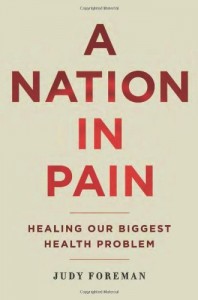By Howard Fields, MD | Pain Research Forum | May 1, 2014

A Nation in Pain, by Boston Globe health columnist Judy Foreman,2014. Foreman is winner of the Foley Journalist Award from the American Pain Society.
Judy Foreman has written a remarkable book about pain. Although aimed at an educated and curious non-professional readership it contains information and perspective that will be of great value to patients, scientists and clinicians as well as those interested in policy. It is a broad based survey of the ‘problem’ covering its prevalence, psychosocial and economic dimensions and perhaps more impressively, a broad survey of current animal, human and clinical research. Despite the breadth and scholarly analysis reflected in the material, the author’s journalistic style and efficient prose make for easy reading. By artful interview and through her own suffering she has captured the predicament and frustration of patients facing both their own pain and the ignorance and rejection of health care professionals. In contrast, she conveys the scientists’ excitement and enthusiasm about their discoveries, all the while remaining objective and open about the limits of their findings. Her chapter on gender and pain is particularly informative. As with most of her chapters it is amply but not exhaustively referenced, providing a guide to deeper inquiry for the reader. In fact, this is one of the reasons the book is so good; Foreman has mastered the skill of providing sufficient information to give the reader a reasonable level of understanding without the burden of detail typical of a scientific paper. Best of all, the text is spiced with direct quotes from leading experts in the field. This was not only enjoyable for me because I know most the individuals personally but, in addition, it gives the reader confidence that the author’s conclusions have been scrutinized and informed by those in the know. The acknowledgements section reads like a who’s who of pain research.
The chapter on opioid use, misuse, efficacy and treatment solutions is the most informed, even handed and useful review of the subject that I have read to date. Her chapter on exercise is quite refreshing and probably one of most valuable for patients, not least because it is outside the realm of traditional health care approaches and is probably one of the best things people with musculoskeletal pain can do for themselves. On the other hand, a couple of the chapters are one-sided almost to the point of hype. For example, she totally advocates the use of cannabis for the treatment of pain, even to the point of suggesting it be sold as a dietary supplement and suggests that it is as effective as opioids for the treatment of pain. In contrast, some important therapeutic advances, such as the mixed amine reuptake inhibitors like duloxetine and venlafaxine are mentioned largely in passing and the mixed action drugs tramadol and tapentadol are not mentioned at all. Her chapter on the immunological contribution to chronic pain is also decidedly one sided and credulous. There is elegant rodent work on the subject; however, the failed clinical trial illustrates how little we understand about most chronically painful human conditions. However, these are minor quibbles and I highly recommend the book, it is thorough, informative and a pleasure to read.
See the review, plus further comments and discussion, on the Pain Research Forum.



